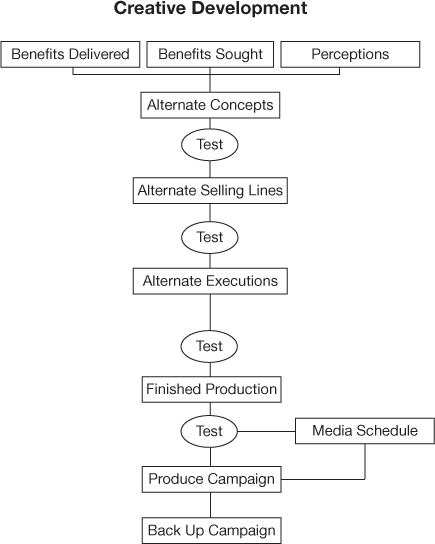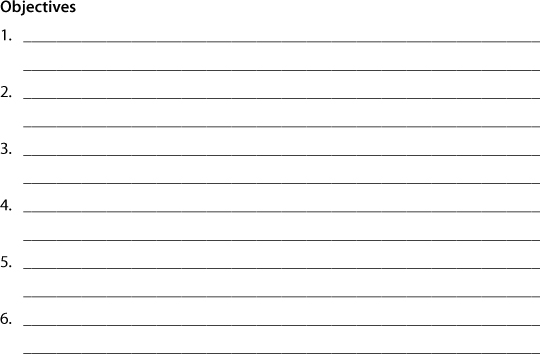17 The Research Plan
You have noticed at the end of each chapter on a marketing component, I have inserted a copy of the Word document into which you insert your objectives and strategies for each part of the marketing plan. These objectives should be written so they are measurable—because unless they are measurable, you cannot monitor them. I believe a plan that is not monitored is not a plan, but just a wish list. You want to monitor your plan every few weeks and make changes if you are off target. Don’t wait until the end of the plan year to check your progress because you may have wasted most of the year by so doing.
You can monitor several of your measurable objectives in-house. Some of these are your number of sales leads, presentations, and closure rate; Internet clicks; reach and frequency; and customer service and public relations activities. To monitor other types of objectives such as your customer analysis, pricing, sales forecasting, and product/service objectives, you may need some outside help.
You could definitely order a benchmark study in which an outside research company can pose questions to your current and potential customers. To test your print advertising, you can use companies such as Starch Research (www.starchresearch.com) and for broadcast advertising, Ipsos ASI Research (www.ispos-asi.com). Focus groups can also be used to find answers to some questions, and although they can be more limited than a benchmark study, they are frequently less expensive. And of course, there is the Internet. Each of these methods will be discussed in the following sections.
In-House Activities
Some marketing people are unaware of all the market data buried within a company, so your first step is to ask around about what is available. Your own marketing department may be a treasure trove. You also want to check with trade associations, trade journals, and the federal government. The federal government has more research data than all the research companies combined. The trick is finding where it is. There is also a ton of information available on the Internet.
Benchmark Studies
Most survey research simply involves surveys among a representative sample of individuals. Very carefully designed questionnaires, usually administered in a structured manner, are used to guide the interview. They could be about attitudes, needs, or preferences. The questions could be “closed-end” (for example, “yes” or “no”) or they could be “open-ended” (“What do you think of. . .?”). There are no right or wrong answers in survey research. You can find research companies by checking the Council of American Survey Research Organization’s (www.casro.org) more than 325 members and using their member directory: You insert your market, description of potential customers, and what type of benchmark study you desire, and a selection of appropriate organizations will be presented to you.
There are several types of benchmark studies: personal interviews, telephone, mail, and e-mail. Personal interviews are the most effective because you can ask more questions, the interviewer can probe and ask follow-up questions, and you can show graphics. The disadvantages are that they are the most expensive and take the most time to complete the study. Telephone interviews can save you time and money, but you have to ask fewer questions and you can’t show graphics. Interviews by mail cost the least of the three “nondigital” methods, but the disadvantages are the low rate of return, and the returns may not represent the universe of respondents you are interested in.
You can also turn to the Internet for your surveys. The Internet allows you to send surveys via e-mail to large numbers of potential participants who can then fill out the surveys on their own time—if they choose to fill them out. These surveys frequently contain similar material to that of surveys done by companies such as Starch, Roper, and Ipsos ASI. The Internet surveys can ask a variety of questions on a particular subject or product offering. For example, the National Basketball Association, Major League Baseball, and the National Hockey League have electronic surveys asking fans all sorts of questions including their feelings and thoughts on that league’s particular ad campaign, on that league’s particular broadcasts, which teams fans like, how often fans go to games, and what fans would prefer to see and do at the game—and more.
You can use a benchmark study to help determine the size of your market, your market share, perception of your price, your complete customer analysis, perception of your business, perception of competition, and other answers you need for your fact book and to measure your objectives.
Advertising Research
Figure 17-1 is a flow chart on creative development that I showed you in Chapter 9, The Advertising Plan. It shows you the different points in the strategy development process you need to text. It’s vital that you understand the importance of testing your advertising concepts.
You can obtain information on benefits sought and benefits delivered from your benchmark study. You can also test your various concepts by drawing them on some 8½-by-11 inch sheets of cardboard and passing them on to the interviewee like a deck of cards. You then ask about their perception of each card (or screen, if you are doing this electronically).
Figure 17–1 Creative development testing timeline.

Research on Your Print Campaign
Starch Research, Roper Canada, Ipsos ASI, and many other companies provide valuable research on your print advertising. These research companies offer surveys conducted by means of personal interviews with readers of specific issues of newspapers, consumer magazines, and business and professional publications.
The first objective of any ad is to be noticed. Any research firm measures this fundamental aspect of advertising performance, as well as measuring the ad’s ability to communicate brand association, and the extent of reader involvement in copy reading. These measures—noting, brand association, and read most—are reported for each ad in a particular magazine issue. This permits a useful context for evaluation, as ad effectiveness is related to scores for other ads of the same size, color, and product category.
Ad norms or averages for specific titles provide a further performance benchmark. Track your own campaign, measure competitive advertising, and learn which elements contribute to high readership scores.
All print advertisements are designed to meet specific communication objectives. Yet few ads are independently evaluated to determine whether the intended message is being conveyed. In fact, some ads inadvertently communicate undesired messages.
These research companies also can provide advertisers with evidence of advertising effectiveness and the return on their advertising investment. Typically, these studies will evaluate each advertisement on the basis of its creative elements (interest, innovation, visual appeal, and attention value) as well as its content elements (clarity, information value, believability, and persuasiveness). Additionally, communication value, relevance, attitude to the product or advertising, and the amount of information contained within the ad will be measured in these studies. An extensive database of norms will provide the context for evaluation.
One or more concept ads are evaluated to help advertisers determine the most effective combination of visuals and copy to achieve the desired communication objectives. Test ads are inserted into a mocked-up magazine or newspaper that respondents are asked to leaf through. Questions are posed concerning ad recall on an unaided, partly aided, and prompted basis. Respondents are asked to read the test ad thoroughly and a diagnostic test is administered.
Research for an Internet Campaign
A source for Internet research you want to check out is emarketer.com. According to Paul Iagnoco, director of global digital strategy at Kellogg’s, “With its articles, charts, and analysis, eMarketer is a whole library of resources for us. eMarketer is the authority—it validates trends and gives credibility to what we’re proposing.”
Another is doubleclick.com. The company’s research team can offer clients deep insights on industry trends, as well as performance metrics and benchmarks. It provides custom campaign analyses, manages individual client-driven research projects, and offers training and best practices presentations and sessions.
A new company by the name of Omniture (www.omniture.com) delivers its customers traffic data as it happens in real time, tracking everything from how many people visit a website to where they’re coming from to how long they linger. Google and some hosting services provide the same information. Quantcast (www.quantcast.com) allows you to obtain the demographics of visitors to your site and can now also place you on sites that meet your demographics.
Below is a worksheet for your research plan objectives and strategies, which you can photocopy or print out from your downloaded folder of worksheets. This is where you list all your measurable objectives from other parts of the plan and spell out how you are going to monitor them. Be sure you put numbers in your objectives so you can keep measuring whether or not you are hitting your target. If you are not on target, then you should consider changing your strategies.
Worksheet 17–1 Research plan: Objectives and strategies


